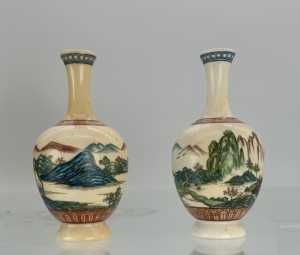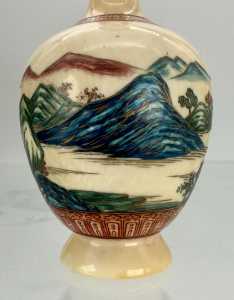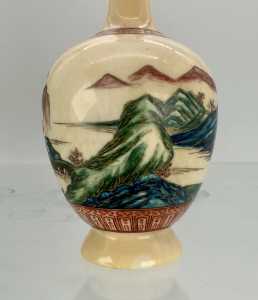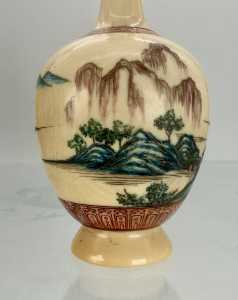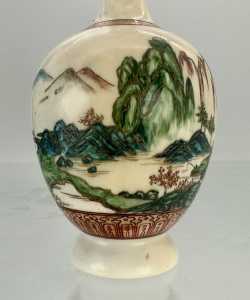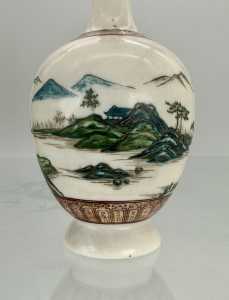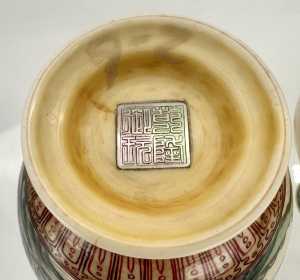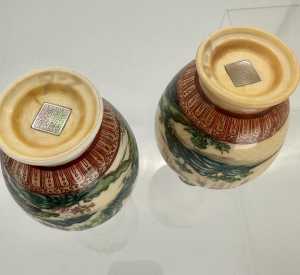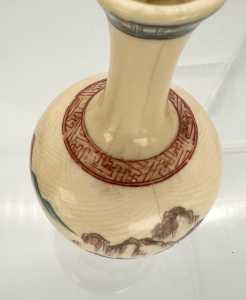The Chinese and Asian Art Forum. For Fans, Collectors and Dealers.
 Basic Rules For the BidAmount Asian Art Forum: Talk about whatever you want. You can even discuss and offer things that are for sale if they are authentic. Maximum image file size per post is 2 MB. Images of 700pxl x 700pxl are optimal if saved at a medium resolution. Be respectful of others and enjoy yourself. Click the YouTube link for a brief tutorial on using the forum. You can also EMBED Videos by cutting and pasting from You-Tube, Vimeo etc.
Basic Rules For the BidAmount Asian Art Forum: Talk about whatever you want. You can even discuss and offer things that are for sale if they are authentic. Maximum image file size per post is 2 MB. Images of 700pxl x 700pxl are optimal if saved at a medium resolution. Be respectful of others and enjoy yourself. Click the YouTube link for a brief tutorial on using the forum. You can also EMBED Videos by cutting and pasting from You-Tube, Vimeo etc.
NOTE: To post an item or add a new post, click open the category title from the FORUM LIST, and CLICK the Blue ADD TOPIC button.
Hey Folks,
So another oddity I just couldn't help but buy. Sold as 20th century, so I am not expecting much. That said, the mark is interesting as is the technique of decoration. The mark is ( I think) Qianlong Yu Wan, which if I understand correctly "for the Imperial enjoyment of the Qianlong"... or something along those lines. These marks are on mostly scholar type objects made in the Qianlong and Jiaqing periods, though there have been 19th/20th pieces that sold for very strong prices in China, like a bit higher than I'd expect for republic pieces, with this mark. The objects are usually Jade, or a combo of hardstone/wood/ivory, or glass, though admittedly I mostly see jade pieces, there were a few ivory table screens that I found on a Chinese site but I couldn't save the links...
Whats weird to me is the "paint" is more like ink or dye, and I have found very little about this type of decoration, virtually no examples from the 20th century, at least in color and not carved, there have been a few grisaille ones though. I also can see that some has worn off but I do not know the extent, like the red border patterns look to have shading or perhaps gilding that is now gone. Acetone would probably remove it all, so not super stable whatever this is. I have dealt with George III dyed ivory handled knives before and this is very similar properties.
The scale is something else, these are small, so while seemingly simple decoration and quickly executed, remember the figures on the bridge are 2mm tall. Overall the height is 128mm, so not tiny but certainly miniature.
So I am curious what you all think, 1920s or so or much later? I do think there is age, I am just not sure if its Proc or earlier.
Cheers,
Jeremy
The decoration is terrible. The material might not have been illegally obtained, but I dont think this is very old.
HI Jeremy,
These are definitely stained/dyed not painted.
Stained ivory was very popular during the later 19th through to the early 20th Century .These are Chinese not Japanese.
What's unusual about these is the round base's. Ivory figure's etc should for larger carvings always have oval not round. There are exceptions of course but not many. Round indicates under normal circumstances for large carvings that the material is resin/other and not elephant ivory. These should be fairly heavy as bone and most resin copies are not. But being perfect rounded base's is definitely not normally correct so I would perform a hot needle test. Alternatively you can perform a UV test but unless you are familiar with the various shading seen on both ivory and resin this may not be helpful.
Ivory should be a bluish-white whereas resin more intense blue to orange but this isn't definitive because of the presence of the dye in the artwork that could present false readings. So I would perform a hot needle test preferably at the base so it's not too destructive etc.
But I can see clearly the shregger lines and though they can be faked (resin) yours look okay. I can also see what looks like a natural crack.
The Chinese were not the master's of carving or decorating ivory. The Japanese were and this is reflected in your vases.
You have a pair which is always better than one. And as Peter often states a pair is times 3.
The style is reminiscent of Wang Yeting a Republic period artist with that heavy blue/black. Almost sloppy.
That silver inlaid I have seen before on ivory but a long time ago. I have also seen it on resin more recently.
I don't think these are 19th Century nor Republic period. I think these are 1950's -60's. Possible 1970's but unlikely due to the style etc.
They are very nice. I like them if they are genuine.
MARK
I kinda like the wishy washy landscapes, but to each his own. I would never call them terrible, simply cause I have seen some truly awful export pieces, these wouldn't even come close. I don't really think they are crazy old but figured maybe republic to PROC.
Jeremy
Hey Mark,
Its funny I was reading your posts as you were editing, while at dinner... your thought process was just like mine when they came in. Not so much the round bottoms, but hot pin test, then UV test. I have quite a few ivory pieces, so I always check when they come in. Sorry I should have mentioned that.
Interestingly I thought the mark was on a piece was silver too, but they are carved mother of pearl.
I have yet to find any Chinese stained ivory that aren't fairly basic, kinda interesting too your point about Japanese ivory. Generally I far prefer the intricate carvings they do. Just happened that these were hard to find a comp for so they intrigued me, plus I really like the landscapes.
Now I need to save up like $50k to get a Wang Yeting landscape, I really like those too.
1960s-80s would make sense to, I just wondered if republic, but those bands of decorations at the rim key, lattice, etc... totally looks like those on PROC porcelain.
Cheers,
Jeremy
Hi Jeremy,
It's possibly Republic period. These can be difficult to dare at the best of times.
Firstly please confirm its ivory.
MOP seal mark. That's very unusual.
Market
I think unusual describes almost everything about them.
Just discovered the neck portion is a separate piece form the rest while trying to get a spider out of one, I'm not going to take it apart but there is definitely a joint at the base of the neck. interesting to say the least.
They are definitely ivory. red hot pin did nothing to note, UV they are the same as my other pieces.
Cheers,
Jeremy
Not surprised that its made of more than one section. Confirms ivory actually on higher probability etc.
I have never seen one with MOP seal insert. Silver yes.
@jbeer2121 The last picture is perfect to show everyone what the cross hatch pattern of natural ivory looks like. Looks the same as antique carved ivory earrings I inherited, if it is antique, there is an exception to total ban in some states, but check before you sell them on to make sure they do not go somewhere with strict ban without exception. My guess is Republic, which means antique or soon will be, like me, so it should fit within an exception in many places or better yet, keep to enjoy. I do not find the decoration objectionable.
Hi, I am going to go against everyone here and say I actually think it's very well done and that the painting/staining is actually very much on par with what you would see on Republic pieces. While it may seem like it's sloppily painted, it's not an easy technique to do, and out of ALL the painted ivory pieces I have come across (mostly snuff bottles) this set far outdoes any of those. The form of these vases are also very Republic imho. You can tell that the quality of these vases is high because the perfect form of the vase, very uniform and well proportioned.
It is 100% ivory, you can see evidence of this in some of your photos. I am certain this would be something you'd buy in the 1920-30s in Shanghai to bring back home from your trip.
The only issue I have is that crazy MOP Qianlong seal, which is also superbly done. I haven't seen anything like that before.
If you plan on selling them, it may be a bit difficult but there are venues you can send ivory pieces to who will provide you a CITIES certificate that states it is pre-ban and can be legally sold, just make sure you look into it first! Either way, very nice vases! It's nice seeing things I haven't seen before.
Thanks for visiting "The BidAmount Asian Art Forum | Chinese Art"
If you sell on eBay, or have a shop feel free to post images and descriptions and links.
Check back often for discussion about the latest news in the Chinese art and antique world. Also find out about the latest Asian art auctions at Sotheby's, Christie's, Bonhams and Tajans.
Auction results for: fine porcelain, ceramics, bronze, jade, textiles and scholar's objects. As well as Japanese, Thai, Vietnamese and other Asian cultures.
Thank you,
Peter Combs
Topics and categories on The BidAmount Asian Art Forum | Chinese Art
Kangxi vases, Kangxi dishes and chargers, Kangxi ritual pieces, Kangxi scholar's objects, Qianlong famille rose, Qianlong enamels, Qianlong period paintings, Qianlong Emporer's court, Fine porcelain of the Yongzheng period. Chinese imperial art, Ming porcelain including Jiajing, Wanli, Xuande, Chenghua as well as Ming jades and bronzes.
The BidAmount Asian Art Forum | Chinese Art
A free Asian art discussion board and Asian art message board for dealers and collectors of art and antiques from China, Japan, Korea, Thailand, Cambodia, Vietnam and the rest of Asia. Linked to all of the BidAmount Asian art reference areas, with videos from plcombs Asian Art and Bidamount on YouTube. Sign up also for the weekly BidAmount newsletter and catalogs of active eBay listing of Chinese porcelain, bronze, jades, robes, and paintings.
The art of calligraphy - and for the ancient Chinese it certainly was an art - aimed to demonstrate superior control and skill using brush and ink. Calligraphy established itself as one of the major Chinese art forms during the Han dynasty (206 BCE - 220 CE), and for two millennia after, all educated men were expected to be proficient at it.
The Museum’s collections of Asian art span nearly five millennia and encompass the cultures of China, the Himalayas, India, Japan, Korea, and Southeast Asia. In 2007, the Museum launched an initiative to create dedicated galleries for the collection, beginning with a gallery for the arts of Korea ...
Chinese art is full of symbolism, in that artists typically seek to depict some aspect of a totality of which they are intuitively aware.
China Online Museum is the finest online museum of Chinese art. It features Chinese calligraphy, painting, ceramics, bronzes, carving, and other artworks.
Chinese Ceramics & Works of Art. Overview Upcoming auctions Contacts Auction results ... Christie’s sales of Chinese ceramics and works of art showcase centuries of Chinese history. Held throughout the year in London, New York, Paris and Hong Kong, they attract a wide audience of collectors and connoisseurs vying for pieces as diverse as ...
Explore Asian Art Week. Contact the Specialist Department. Chinese Paintings ... Senior Specialist, Head of Sale. [email protected]. Tel:+1 212 641 5760. Bid in-person or online for the upcoming auction:Fine Chinese Paintings on 10 September 2019 at New York. Bid in-person or online for the upcoming auction:Fine Chinese Paintings on 10 ...
Discover an abundance of must-see art from all corners of a vast continent at Christie’s NY Asian Art Week. From contemporary classical and Chinese paintings to works with exemplary provenance from the Art Institute of Chicago, our Rockefeller Paza galleries will be full of ancient treasures and contemporary masterworks in a salute to the vibrant arts of Asia.
Sold to benefit The Art Institute of Chicago’s Asian Art Acquisition Fund, the sale features 84 lots with a focus on Ming and Qing porcelains, and offers a rare insight into the taste for collecting Chinese ceramics and works of art in the Midwest from the end of the 19th century through the 1980s. Highlights include two Wanli wucai garlic-head vases, a Qianlong mark and period, blue and ...
Specialist, Chinese Paintings, Christie's London Dr Malcolm McNeill is a Specialist in Chinese Paintings at Christie’s, based in London. He previously worked as an assistant curator of the Chinese collections and the Victoria and Albert Museum in London, as a researcher at the British Museum, and as a translator and tour guide at the National Palace Museum in Taipei.
The Christie's Education 2020 Conference: The Chinese Art Market 18 Jun 2019 Christie’s Education is delighted to announce our first international academic conference in Asia which will take place in Hong Kong from 26-27 November 2020 at the Hong Kong Convention and Exhibition Centre and will run in parallel with Christie’s Hong Kong Autumn Auctions.
The summer Chinese Art sale in Hong Kong will feature works of art from several private collections, including Qing porcelains and textile from the collection of the legendary Chinese art dealer A. W. Bahr (1877–1959), fine gilt bronze Buddhist sculptures from an old Hong Kong collection, an East Asian collection of Qing dynasty wine cups and jades, and a Japanese collection of Song ceramics ...
Sotheby's Chinese Works of Art Department holds two auctions each year in London, New York, Hong Kong and Paris.
Chinese Art - View Auction details, bid, buy and collect the various artworks at Sothebys Art Auction House.
With more than 340 Chinese works of art dating from the Neolithic to the Republic periods, highlights of this sale include a selection of Qing Imperial monochromes from the collection of Arnold and Blema Steinberg, early ceramics from the Art Institute of Chicago and Chinese porcelain and works of art from the collection of Henry Arnhold.
Results: Sotheby's Asia Week achieved $52.4 million in six strong auctions, exceeding pre-sale estimates. With 76.5% of lots sold and 60.3% of lots surpassing high estimates, the Asian art sales at Sotheby's indicate continued collector interest in the finest works of art from China, India and and the Himalayas.
Today's sale of Important Chinese Art will proceed as planned with sessions at 10 AM and 2 PM EDT. Sotheby's will be monitoring the weather conditions throughout the day and will be available to coordinate alternative bidding options should conditions make it difficult for clients to attend the auction in person.
Bonhams Chinese Art department is renowned for offering the finest works of art representing the richness and breadth of China's artistic heritage, particularly Imperial porcelain, white and spinach green jades, cloisonné and Buddhist art. Specialised international auctions are held globally, including London, Hong Kong and San Francisco.
Bonhams : Chinese Works of Art We use cookies to remember choices you make on functionality and personal features to enhance your experience to our site. By continuing to use our site you consent to the use of cookies. Please refer to our privacy and cookie policies for more information.
Bonhams Fine Art Auctioneers & Valuers: auctioneers of art, pictures, collectables and motor cars. We use cookies to remember choices you make on functionality and personal features to enhance your experience to our site. By continuing to use our site you consent to the use of cookies. ... Chinese Art (US) General enquiries
Bonhams : Fine Chinese Art We use cookies to remember choices you make on functionality and personal features to enhance your experience to our site. By continuing to use our site you consent to the use of cookies. Please refer to our privacy and cookie policies for more information.
Bonhams Fine Art Auctioneers & Valuers: auctioneers of art, pictures, collectables and motor cars Bonhams : Asian Art We use cookies to remember choices you make on functionality and personal features to enhance your experience to our site.
Bonhams are international auctioneers of fine Chinese and Japanese art. We specialise in rare Imperial and Export Chinese ceramics and works of art, as well as Japanese ceramics, fine and decorative works of art from the Neolithic Period to the 20th century. View on map
Bonhams Fine Art Auctioneers & Valuers: auctioneers of art, pictures, collectables and motor cars. We use cookies to remember choices you make on functionality and personal features to enhance your experience to our site. By continuing to use our site you consent to the use of cookies. ... Asian Art Bonhams. Work. 22 Queen St.
